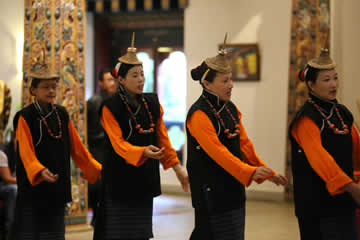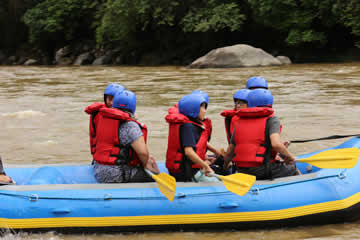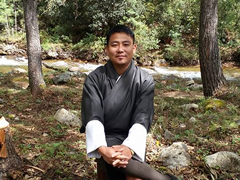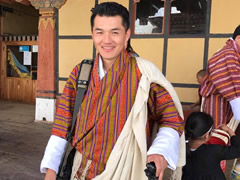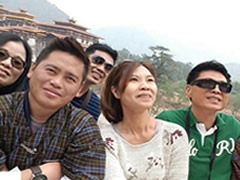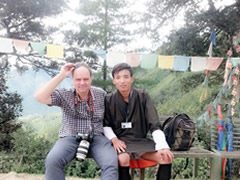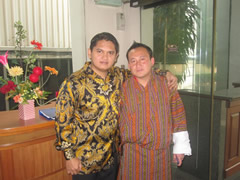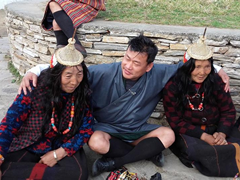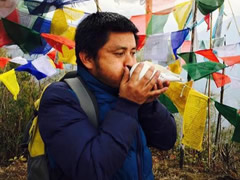8 Night 9 Days Dochula Festival Tour
When is Dochula Festival ? Answer: Every year in 13th December
Druk Wangyel Festival is an annual festival held on December 13th at the Druk Wangyal Lhakhang Festival Ground located at Dochula Pass around 22km from the capital city Thimphu.
The Dochula Druk Wangyel Festival was established in 2011 in commemoration of His Majesty the Fourth Druk Gyalpo and the Armed Forces’ victory over Indian insurgent forces residing in southern Bhutan in 2003.
Tour Highlights
- Witness sacred dances and rituals performed by Armies with colourful costumes.
- Join in with locals in a special occasion of celebration, blessings and socializing.
- Explore Phobjikha Valley, winter home to the Black-Necked Crane.
- Visit many cultural attractions including medieval fortresses (Dzongs), markets and museums.
- Hike up to the famous Taktsang Monastery, as we believe that visiting one time Tiger nest is equivalent to visiting 1000 temples.
- Marvel at the elaborate and ancient wall paintings and carvings in Dzongs and temples.
- Finding Happiness in Action Bhutan tours with Varieties of Bhutanese games and sports.
- Visit one of the farm house and have hot stone bath.
- Meet with one of the great master to listen the teaching of Buddhism.
- Leisure walk in Town to have souvenirs and etc
Detailed Itineraries
|
Day 1 |
Paro On arrival at the Paro International Airport, you will be received by your local Bhutanese tour guide from Zoid Jin Tours. Transfer to your hotel in Paro and have a refreshment/lunch. Today your Bhutan tour begin by visiting the following: · National Museum: On a ridge immediately above Rinpung Dzong is the Ta Dzong (watchtower), built as a watchtower to protect the Dzong from intruders and warring factions. In 1968 Paro’s Ta Dzong was inaugurated as the National Museum, and now holds a fascinating collection of art, relics, religious thangkha paintings, Bhutan’s exquisite postage stamps, coins and handicrafts, together with a small natural history collection. · Paro Dzong (Rinpung Dzong): Explore the Rinpung Dzong which the locals call the ‘fortress of a heap of jewels’. Built in 1646 by Zhabdrung Ngawang Namgyal, the dzong stands on a hill above Paro Township. It is linked by the traditional cantilever bridge (called the Nemi Zam) over the Pa chu (Paro river) where one may pose a photograph. Experience a walk up a paved stone path running alongside the imposing outer walls. Once inside the Dzong, you can visit the temples inside the dzong. Farm houses: Picturesque farm houses dot the valley amongst fields and hillsides. In the evening you can stroll around Paro town and you may visit local Bhutanese handicraft stores. Overnight at a hotel in Paro. |
|
Day 2 |
Paro-Punakha/Wangduephodrang & Punakha Tours / Sightseeings Distance: 125 km, estimated travel time: 3 ½ hrs After breakfast, your Zoid jin tour guide and driver will drive you to Punakha & Wangdue. This route will take you through Chunzom (confluence of Pachu- the river flowing through Paro valley & Wangchu –the river flowing through Thimphu valley). On the way, you may stop to visit Tachog Lhakhang (temple) , this 14th century temple located on the base of a mountain across the Pa chu on the Paro-Thimphu highway, is a must visit temple in the Paro valley. Built by the great master architect Thangtong Gyalpo, the temple houses some unique statues. To get to the temple one may actually walk over the iron chains that spans over the Pa chu. After crossing Chunzom, you will travel along the Wangchu upto Simtokha. Here the road diversion leads you to Punakha/Wangdue through Dochula Pass (3,088m/10,130ft). In the clear sky; enjoy the panoramic view of the Himalayan mountain ranges. Then pass by the beautiful 108 chortens built on the hill by Her Majesty Ashi Dorji Wangmo (Queen Mother of Bhutan) for the security and well being of His Majesty, the King of Bhutan. And also visit Druk Wangyal Lhakhang (temple) .The temple was built to honor His Majesty the fourth Druk Gyalpo, Jigme Singye Wangchuck. The past and future appear to merge in the details of the lhakhang that tells the story of a supreme warrior figure whose vision pierces the distant future. Then travel onto Punakha. Punakha has been inextricably linked to some of the most momentous events in the Bhutanese history and deserves its reputation as one of the most beautiful and significant regions at the heart of Bhutanese culture. Punakha had served as the capital of Bhutan from 1637 till 1907 and the 1st National Assembly was held here. The dzong is historically important and stands as the symbol for a unified Bhutan. On the way visit the Divine Madman’s Monastery-Chhimi Lhakhang, famously known for its fertility shrine, where one can receive a special fertility blessing. After lunch visit the Punakha Dzong, located on the island of the Pho - Chu (male river) and the Mochu (female river). The dzong was built in 1637 by Zhabdrung Ngawang Namgyal to serve as the religious and administrative seat of the region. It was here that the dual system of government was introduced in the 17th century and in 1907, enthroned the first King Gongsar Ugyen Wangchuck. Damaged over the centuries by four catastrophic fires and an earthquake, the dzong has been fully restored in the recent years by the 4th King Jigme Singye Wangchuck. At the dzong, you can see the highest standards in woodwork. Also visit the massive Kuenray, the Coronation Hall of all Bhutanese kings, the Dzongchung at the entrance to the dzong and the cantilever bridge over the Mochu that has been recently renovated. Overnight at a hotel in Punakha/Wangdue. |
|
Day 3 |
Khamsum Yuelley Namgyal Lhakhang Hike – Phobjikha Valley In the morning after breakfast, drive through upper Punakha valley passing through farm houses and take a short hike through farmhouses to the beautiful Khamsum Yuelley Namgyal Lhakhang (temple built by the Queen Mother of Bhutan for peace and stability in this ever-changing world. This temple is situated on the hilltop overlooking the valley below. The leisurely walk up to the temple would take about 1 hour. Visit the temple and also enjoy the breathtaking view from there. · Water Rafting: While coming back from Khamsum Hike, there in our base we have a water rafting facilities and so if interested you can avail those facilities else you will be drive back to Punakha and on the way you will be stop at Zomilithang to visit newly built Stupa for the circumambulation. After lunch we will drive to Phobjikha valley. Driving through the dense forests of the Phobjikha Valley you arrive at Gantey village where you see the Gangtey Monastery and visit the monastery. Phobjikha valley is part of the beautiful Jigme Singye Wangchuck National Park ( formerly known as Black Mountains National Park), one of Bhutan’s most important nature sanctuaries. Each winter it is home to a flock of 300 rare and endangered black-necked cranes. The surrounding hills and mountains are home to nomadic shepherds and yak-herders. This is one of the most remote and untouched regions in Bhutan and is only just opening its doors to the outside world. Then Visit: · Gangtey Monastery : Gangte Goemba / Gangtey Monastery enjoys the valley's prime real estate, on a forested hill overlooking the green expanse of the entire Phobjikha valley. · Black Necked Crane Centre: These black necked cranes migrate from Tibet in late autumn and typically stay till the mid march. Black Necked Crane Information Centre is situated on the edge of the forest and wetland below Gakiling hotel. Hotel and overnight at Phobjikha valley |
|
Day 4 |
Phobjikha – Dochula Festival After breakfast make a drive back to Dochula to witness the whole Dochula Festival. In the clear winter sky you will get to enjoy the panoramic view of the Himalayan Mountain ranges. Dochula Druk Wangyel Festival program Azhe Lham (Folk Dance) Dance of Gadpo Ganmo (mask dance) Neyang Dochula written by karma Ura (Folk dance) or Dance of Jetsun Milarepa and Tsering Chednga. Part I. Jetsun Milarepa and Five Enchantresse (Mask dance) Pawo Palden Drukpa written by HH Je Khenpo (Folk dance) Part II. Jetsum Milarepa and Five Enchantresses (Mask dance) Part III: Jetsun Milaraepa and Tshering Chednga (Mask dance) Neladangpamichag by HH Je Khenpo (Folk dance) Gakid Palzom by Gonpo Tshering (Folk dance) Ngonjon Gyalwagongma (Folk dance) Phodrang Dangpa Michag Folk dance) Gyalwa Shacha Muni written by Gonpo Tshering (Folk Dance) Dance of the Heroes. Part I. Farewell of the Heroes (Folk dance) Druk Puna Dechen (Folk dance) Luchochig Lhadangsungma Chod by HH Je Khenpo (Folk dance) Part II. Combat of the Heroes (Mask dance) Lha Ugyen Pema by Gonpo Tshering (Folk dance) Sharitseney by HH Je Khenpo (Folk dance) Kidpu Drukgyi Tsenden By HH Je Khenpo (Folk dance) Part III: return of the Heroes and Encounter with Boddhisattvs (Mask dance) Tashi Labey ( Farewell folk dance)
After the festival drive to Thimphu and overnight stay at hotel in Timphu. |
|
Day 5 |
Thimphu Sightseeing After breakfast visit: · Memorial Chorten also known as the Thimphu Chorten, is a stupa built in memory of the 3rd King of Bhutan, Jigme Dorji Wangchuk by his mother Queen Ashi Phuntsho Choden Wangchuck. Kuenselphodrang where the Bhutan’s largest Buddha statue is perched on the hillock overlooking the entire Thimphu valley below and the view from there is magnificent. Craft Bazaar where craftsmen and artisans from across the country display and sell their handicrafts. Changangkha Lhakhang The temple is one of the oldest in Thimphu, built in the 12th century and is located above the main town of Thimphu overlooking the Thimphu valley. Nunnery (Thangtong Dewachen Nunnery) The nunnery, popularly known as Zilukha Anim Dratshang is located above Zilukha Lower Secondary School, overlooking Tashichodzong in Thimphu valley. It is a few minutes’ drive from the main Thimphu town. After lunch visit: · Takin Preserve, which houses the national animal the Takin that is only found in Bhutan. This is an extremely rare member of the goat family. Found in herds in the very high altitudes (13,125ft and over). They live on a diet of grass and bamboo. It can weigh as much as 550 pounds. · Watch Archery match ( Bhutan’s national game) · Centenary Farmers’ Market (open from Thu-Sun only): Most of the Thimphu’s population and many valley dwellers converge on the bustling weekend market, held by the side of Wangchu River. A wide range of foodstuffs and local arts and crafts are sold at the market, which runs from Friday afternoon till Sunday evening. A visit to the market provides great photo opportunities, as well as the chance to mingle with local people. · Tashichhoe Dzong, a fortress of the glorious religion. It was built in 1641 by Zhabdrung Ngawang Namgyel and was reconstructed into present structure by the late King, His majesty Jigme Dorji Wangchuck in the year 1962-1969. It houses the secretariat building, the throne room and the office of the king, and the central monk body. · School of Traditional Painting of Arts and Crafts where students undertake a six-year course on the 13 traditional arts and crafts of Bhutan. · Craft Bazaar where craftsmen and artisans from across the country display and sell their handicrafts.
Overnight at Thimphu |
|
Day 6 |
Thimphu – Haa Valley Home Stay After breakfast you will drive from Chuzom by making left hand drive to Haa valley where you will enjoy the three mountains of Haa valley. Visit: White and black temple. Overnight at one of the home stay at Haa Valley
|
|
Day 7 |
Haa Valley – Chelela Pass – Paro Sightseeing Chelela Pass separates Haa and Paro Valley and at 3810 m. It is one of the highest motor able pass in Bhutan. The drive till here either from Paro or Haa is through dense spruce and larch forests according to the seasons. On a clear day, there are spectacular views of Mt. Jumolhari, Jichu Drake and adjoining peaks to the nort west as well as the view of Haa and Paro Valley. After Lunch Visit: Drugyel Dzong: now in ruins is located 14kms north of Paro town, near the end of the paved road. Its name means victories fortress and was built 1644-49 to commemorate the Bhutanese victory over the Tibetan-Mongol forces. It was later burnt in fire by accident in 1951. On a clear day, Mt. Jumolhari, Bhutan's holy peak can be seen against its backdrop. Now the reconstruction of the Dzong is still going on to the same structure as before. Then travel back to your hotel, on the way visiting Kyichu temple,one of the 108 temples built in the 7th century by the Tibetan King Songsten Gampo. The story goes that a giant demon lay across the whole area of Tibet and the Himalayas and was preventing the spread of Buddhism. To overcome her, King Songtsen Gampo decided to build 108 temples, which would be placed on all the points of her body. Kyichu Temple is one of the 108 temples. In the evening you may relax in the traditional hot stone bath by visiting farm house to experience the real Bhutanese life style. In the evening stroll through Paro town and you may visit local shops. |
|
Day 8 |
Paro- A Hike to Paro Takshang ( Tiger nest Temple ) After breakfast, hike up to Taktsang Monastery, also known as ‘Tiger’s Nest’. The climb up to the viewpoint will take around 1 ½ hours and from there you will enjoy a spectacular view of the monastery clinging to the side of the cliff. Stop for refreshment at the View Point Cafeteria.Then walk further up to the monastery which will take another 1 ½ hour. It is said that in the 8th century Guru Rinpoche flew on the back of a tigress from eastern Bhutan to this place and meditated in a cave here for 3 months. The principal Lhakhang (monastery) of the present monastic complex dates from 1692. Taktsang was damaged severely by fire in 1998 but has now been fully restored to its former glory.After visiting the monastery, walk back down to the road on the way stop for lunch at the view point cafeteria and then walk further down to the road point. Gathering and dinner with Managing Director of Zoid jin Tours and its teams. Dinner and overnight at a hotel in Paro. |
|
Day 9 |
Zoid Jin Tours & Treks (your local Bhutan travel agent) will see you off at the Paro Airport for your onward destinations to Bangkok. |
*** Remember the Itineraries can be change depending upon the interest of our tourist visiting Bhutan through Zoid Jin Tours.
Please feel free to share any kind of doubts about visiting Bhutan, Zoid jin tours has answers for you …
With warm Regards

Kelzang Dorji
Tour Operator, Bhutan
Dochula Festival Tour Cost
| Tour Cost for 1 person | $1,920 ( USD one thousand hundred and twenty only) | Includes single person surcharge of $40 per night |
| Tour Cost for 2 people | $1,680 (USD one thousand six hundred and eighty only) | Includes two people surcharges of $30 per night |
| Tour Cost for 3 people & above | $1,440 (USD one thousand four hundred and forty only ) | No surcharges is applicable for 3 people and above. |
The above Bhutan tour cost includes:
- Bhutan Government Royalty of US$65 per night per person
- Twin sharing hotel Rooms at 3 star hotels
- All Meals at 3 star hotels
- English speaking tour guides
- All transportation's within Bhutan
- All entrance fees to museums and monuments
- All internal taxes and charges
- Fresh drinking Mineral water
- Extra Guide's while Hiking
The above Bhutan tour cost doesn’t includes:
- Visa fee US $40 each
- Airfares (optional)
- Travel insurance (recommended but not available in Bhutan)
- Other personal expenses, calls overseas and other more
- Guide and driver tipping's


